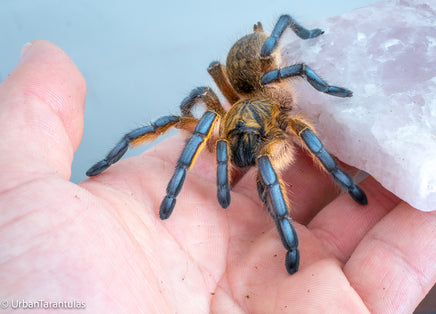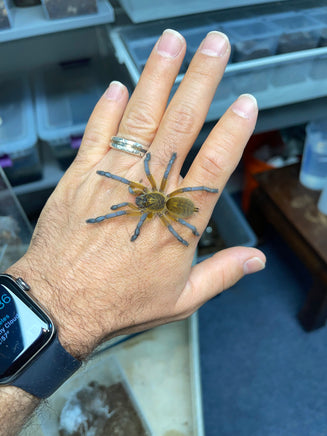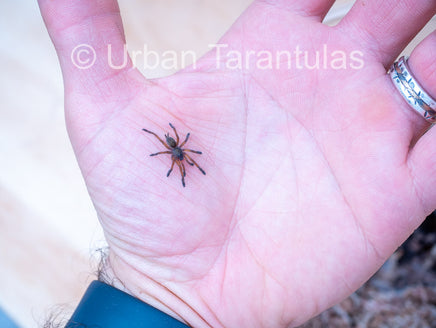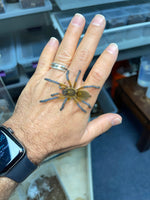Harpactira pulchripes – The Golden Beauty of Africa
THE BEST BEGINNER OLD WORLD TARANTULA
This one stops you in your tracks. The Harpactira pulchripes, also known as the Golden Blue Leg Baboon, is a visual masterpiece—golden carapace, velvety body, and electric blue legs. One of the most sought-after African species for both its looks and manageable attitude. It’s an Old World baboon, but it doesn’t come with the chaos you'd expect. Very secretive, very calm. A treasure in any collection.
🕷️ Care Details
-
Temperature: Ideal range is 75 to 85°F (24 to 29°C). Tarantulas in warmer setups eat more, grow faster, and molt quicker.
-
Humidity: Target around 50%. Don’t overthink it—keep substrate lightly moist on one side and dry on the other. Works great.
-
Housing – Terrestrial species:
-
Babies do great in a 1oz to 4oz deli container with ventilation.
-
Free deli container available at checkout—just ask for it when you place your order. If you don’t, I won’t know to include it.
-
Juveniles and adults do well in an enclosure 2 to 3 times their size, with deep substrate for burrowing and some anchor points for webbing.
-
They love rearranging their space, so give them options.
-
🦗 Feeding Info
I rotate between crickets and roaches—Dubia, Red Runners, Lobsters, and Hissers. For slings, baby crickets or baby roaches work great.
Can’t find small prey? Crush the head and leave it overnight. Your tarantula will find it.
Remove any uneaten feeders the next day to avoid mold or mites.
Bonus treat? A pinky or small lizard every once in a while—but don’t overdo it - only for specimens that are large enough to take them down.
📚 In-Depth Facts
-
Latin name: Harpactira pulchripes
-
Common names: Golden Blue Leg Baboon, Golden Baboon
-
Locale: Eastern Cape, South Africa
-
Category: Terrestrial, heavy webber, occasional burrower. Secretive but not aggressive.
-
Size: Females get to around 5–5.5 inches. Males a little smaller.
-
Urticating hairs: Nope. This is an Old World species—no hairs, just attitude (but this one’s chill).
-
Growth rate: Medium to fast. Especially in warmer temps with regular feeding.
-
Life span: Females up to 15 years, males 3–4 years.
-
Recommended for: Intermediate keepers and up—but honestly, even beginners with respect for Old World species will do fine. It’s a great entry into African tarantulas.
🔗 Stay Connected
-
Instagram: I’m most active here.
-
YouTube: For care videos and deep dives.
-
Facebook: Real reviews from real customers.
-
TikTok: For short-form content and cool feeding clips.
⚠️ Safety Disclaimer
Experiencing a tarantula bite is an extremely rare occurrence, and it's important to note that there have been no recorded fatalities due to a tarantula bite. The venom potency varies across species, with Old World tarantulas generally having stronger venom than their New World counterparts. Within the Old World category, the Poecilotheria genus is known for having particularly potent venom.
It’s crucial to approach tarantulas with respect and understanding. If you happen to get bitten, which is unlikely, the key is to stay calm. In most cases, the discomfort is superficial and subsides within a few minutes to a few hours. However, bites from species with more potent venom may result in symptoms lasting up to a week. Remember, larger tarantulas tend to have more venom than smaller ones.
Please be aware that I cannot assume responsibility for bites. Tarantula handling should be done at your own risk. In my 11 years of experience with these creatures, I have only been bitten once, by a species with highly potent venom. While the experience was painful, the symptoms had completely disappeared after a week.
Handle tarantulas responsibly, and always prioritize your safety and the well-being of the tarantula.













